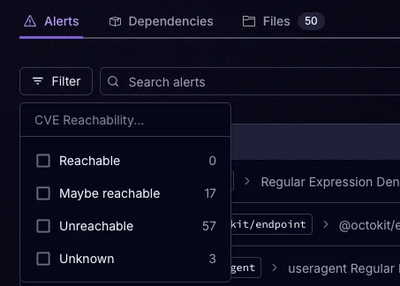
Product
Introducing License Overlays: Smarter License Management for Real-World Code
Customize license detection with Socket’s new license overlays: gain control, reduce noise, and handle edge cases with precision.
github.com/wdamron/amt
Package amt implements the Hash Array Mapped Trie (HAMT) in Go (1.18+ generics).
See "Ideal Hash Trees" (Phil Bagwell, 2001) for an overview of the implementation, advantages, and disadvantages of HAMTs.
The AMT implementation has a natural cardinality of 16 for the root trie and all sub-tries; each AMT level is indexed by 4 hash bits. The depth of a map or set will be on the order of log16(N).
This package uses unsafe pointers/pointer-arithmetic extensively, so it is inherently unsafe and not guaranteed to work today or tomorrow. Unsafe pointers enable a compact memory layout with fewer allocations, and effectively reduce the depth of a map or set by reducing the number of pointers dereferenced along the path to a key or value. No attention is paid to 32-bit architectures since it's now the year 2000, but compatibility may still be there.
An alternative approach, using an interface type to represent either a key-value pair or entry slice (sub-trie), has a few drawbacks. Interface values are the size of 2 pointers (versus 1 when using unsafe pointers), which would increase the memory overhead for key-value/sub-trie entries by 50% (e.g. 24 bytes versus 16 bytes on 64-bit architectures). If the interface value is assigned a slice of entries (sub-trie), a new allocation (the size of 3 pointers) is required for the slice-header before it can be wrapped into the interface value. Accessing an entry slice (sub-trie) through an interface value requires (1) dereferencing the interface's data pointer to get to the slice-header (among other things), then (2) dereferencing the slice-header's data pointer to access an entry in the slice. Unsafe pointers eliminate the extra allocation and overhead of (1), allowing entries to point directly to either a key-value struct or an array of entries. Generics enable a type-safe implementation, where the key-value type of a map or set is fixed after instantiation.
import "github.com/wdamron/amt"
The memory layouts of Go interfaces and slices are detailed in the following articles:
FAQs
Unknown package
Did you know?

Socket for GitHub automatically highlights issues in each pull request and monitors the health of all your open source dependencies. Discover the contents of your packages and block harmful activity before you install or update your dependencies.

Product
Customize license detection with Socket’s new license overlays: gain control, reduce noise, and handle edge cases with precision.

Product
Socket now supports Rust and Cargo, offering package search for all users and experimental SBOM generation for enterprise projects.

Product
Socket’s precomputed reachability slashes false positives by flagging up to 80% of vulnerabilities as irrelevant, with no setup and instant results.